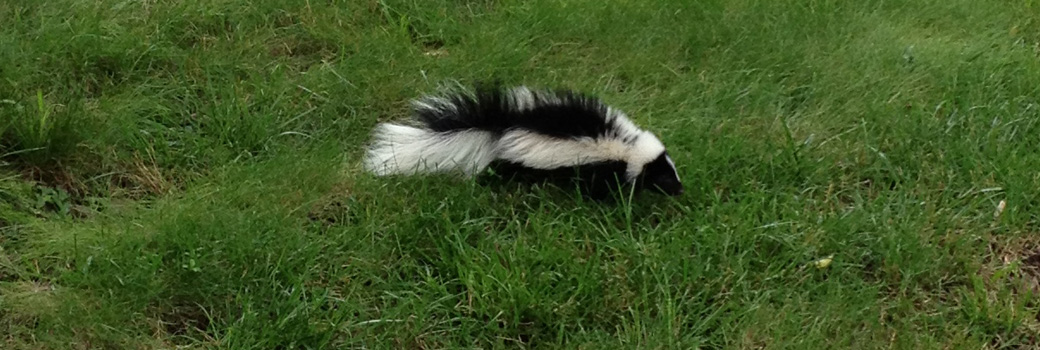- Sacramento Educational Article of the Month - About California Skunks: Life Cycle, Habitat, Behavior
About California Skunks: Life Cycle, Habitat, Behavior
Skunks are vertebrates known for their capacity to shower a fluid with disgusting scent. Distinctive types of skunk change in appearance from highly contrasting to cocoa or cream hued. However, all of them have striking hues.
In North America, skunks are the real transporters of rabies. Rabies is a viral sickness that influences the sensory system of warm-blooded creatures. This ailment is regularly spread by the nibble of a rabies-contaminated creature and is lethal once side effects create. Rabies has been available in the skunk populace of southern Alberta, at fluctuating levels, subsequent to the late 1970s. Any skunk acting anomalous, for example, being agreeable or dynamic amid light hours, ought to be evaded and reported without a moment's delay to the closest Agriculture Agri-Food Canada veterinarian.

Recognizable features
The striped skunk, mephitis, is the most widely recognized of four skunk species found in North America. It is the one and only variety present in Alberta. The striped skunk can be found over the region. It is described by a dark body with a restricted white stripe on the brow and more extensive stripes that stretch out from the neck along every side of the back. Some white variety may likewise, dark shaggy tail. The body size is similar to a house feline, with most grown-up skunks measuring around 74 cm long and weighing around 2 to 4 kilograms. Skunks have sharp paws on the front feet utilized for burrowing bugs and worms. Their foot shape is distinct from other creatures.
Science, Behavior and Reproduction
Skunks are individuals from the weasel family, all of which have aromatic organs on the rear-end. Be as it may, the skunk has the most exceptional aroma organ of all. The organs contain roughly 15 cc of a yellowish, slick fluid. This liquid is a sulfur compound. A skunk can release a shower of this liquid to the extent 4 to 5 m and splash up to six times in progression. It takes up to 10 days to recharge the supply of fluid after full release.
Attributes of skunk
The general elements of skunks are:
1. Skunks are nighttime creatures, dynamic and bolstering amid night hours.
2. Their conduct is moderate and conscious, and they seem positive about shielding themselves against different creatures. Prior to a skunk releases its scent, it will ordinarily give a notice by:
• stamping its feet quickly
• raising its tail straight up
• clicking its teeth
• snarling
• murmuring
3. A skunk splashes, if all else fails, to withdraw from risk.
4. Skunks eat creepy crawlies and rodents additionally go after eggs and young waterfowl and flying creatures. They infrequently cause issues in honey bee yards by sustaining on honey bees as they rise up out of the hive.
5. Skunks additionally sporadically go after homestead poultry farms.
Skunk propagation
Skunks practice close family ties. They additionally support polygamy. The following is a rundown of their general conjugal practices:
1. One adult male and a few (up to 12) females, assemble at and cohabitate a winter nook site from fall until spring.
2. Skunks don't sleep yet by and stay inert amid winter, making due on their fat to store. They may leave the winter sanctum for a brief period when temperature rises.
3. Skunks mate amid February and March. A few females may be mated by one male. Subsequent to mating, female skunks scatter from the winter to find nook to different maternal hiding places.
4. Grass is generally accumulated and brought into the maternal sanctum for bedding.
5. Generally, 4 to 7 youngsters are conceived around nine weeks subsequent to mating in May or June. The youngsters are visually impaired and has no hearing from childbirth.
6. Adult male skunks don't participate in raising offsprings. The young are breast fed for around six weeks prior to joining their mom on treks outside the sanctum.
7. By the time they are grown-ups. The young are weaned by around two months of age.
8. The family separates when the fall arrives. Then, young move to a new domain.
9. You have to transport them away as far as 50 km from where you find them. Otherwise, they can easily come back.
Anti-agents
Lights, sounds, and chemicals frighten them. Moth balls or smelling salts absorbed clothes, may briefly shoo them from entering the zone.
How to get rid of skunks
You may discharge them at a protected area and shoot them with a shotgun, or wrap the trap firmly in plastic and after that gas with propane for around five minutes to suffocate the skunk.
Toehold and body-grasping traps are not suggested for getting skunks, particularly around homes and yards. Skunks regularly splash when gotten in these traps. Generally, skunks have no order of wildlife protection at all.
To learn more about our services, visit the Sacramento wildlife removal home page.

